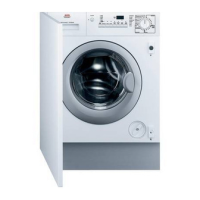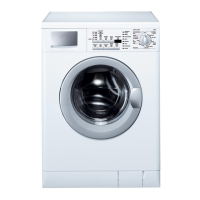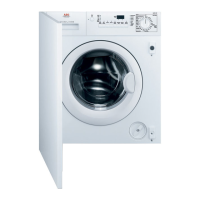
Do you have a question about the AEG LAVAMAT 12820 TURBO ELECTRONIC and is the answer not in the manual?
| Loading type | Front load |
|---|---|
| Load Capacity | 8 kg |
| Maximum spin speed | 1200 RPM |
| Energy Efficiency Class | A |
| Spin Speed | 1200 RPM |
| Programs | 15 |
| Type | Washer |
| Dimensions (H x W x D) | 85 x 60 x 59 cm |
Covers safety rules for repairs, unplugging, and handling the appliance.
Initial setup procedures and precautions for appliance installation and first use.
Guidelines for domestic use, modifications, and specific operational rules.
Information on recycling packaging components like polyethylene, polystyrene, and polypropylene.
Instructions for disposing of the old appliance at authorized sites.
Identification of parts visible from the front of the appliance.
Description of the main program selection dial and its sections.
Allows manual setting of drying duration for cottons and synthetics.
Details on additional wash program options like Stain and Quick.
Information on the prewash cycle for heavily soiled laundry.
How to adjust the final spin speed for different fabric types.
Function to keep laundry in rinse water to prevent creasing.
Understanding program phase indicators and end-of-cycle signals.
Modifying selected program settings while the machine is running.
Conditions and procedure for opening the door after the programme has started.
Initial machine preparation steps, including running an empty cycle.
Guidelines for sorting and preparing clothes for washing.
Understanding garment care symbols and fabric types for selection.
Instructions for washing wool, wool mix, and silk fabrics.
Choosing the right detergent and additives for washing machines.
Factors affecting detergent dosage: load, soil, and water hardness.
How to use liquid detergents directly or with a special dispenser.
Adding water softeners (descaling products) based on water hardness.
Levels of water hardness in German and French degrees.
Maximum load for drying cottons (3 kg) and synthetics (2 kg).
Items like delicate fabrics, those with metal inserts, or foam-rubber padding.
Variables influencing drying time: spin speed, degree, laundry type, and load size.
Adjusting drying settings mid-cycle using pause and selection.
Cleaning the tub after drying fluffy items to remove residue.
Step-by-step guide for using the drying function, including timed and electronic options.
How to correctly load clothes into the drum, one item at a time.
Instructions for using the dispenser drawer for detergent and fabric softener.
Activating additional program features based on laundry needs.
Adjusting spin speed and selecting the Rinse Hold option.
Setting a delayed start time for the wash programme.
Initiating the wash cycle by pressing the start button.
Understanding program phase indicators and end-of-cycle signals.
Actions to take when the cycle finishes, including water emptying.
Table detailing various wash cycles, temperatures, fabrics, and consumption.
Table showing drying options, fabric types, max load, spin speed, and duration.
Daily checks and actions after each wash, including drying the drawer and leaving the door ajar.
Regular maintenance procedures for the appliance.
Procedures for inspecting and cleaning the drain pump.
Manual draining in case of malfunction or to remove water.
Protecting the machine from damage in sub-zero temperatures.
Explanations for normal operation sounds and reduced water levels.
Steps to resolve common issues before calling for service.
List and meaning of error codes displayed by the machine.
Diagnosing problems where the machine fills and then immediately empties.
Fixing problems related to the machine not draining or spinning.
Identifying and fixing sources of water leaks around the appliance.
Resolving issues where the appliance door cannot be opened.
Resolving problems related to ineffective or incomplete drying.
Causes and solutions for greyish laundry and lime scale in the drum.
Specific causes for grey stains, such as insufficient detergent or low temperature.
Explaining persistent foam, which may be normal with modern detergents.
Causes of white residue and suggested solutions like checking detergent choice.
Safety guidelines for those installing the appliance, covering weight and unpacking.
Visual representation of the appliance with key dimensions.
Diagram of the rear showing water inlet, power cable, and drain connections.
Steps to remove transit bolts, packing materials, and plastic pins.
How to ensure the machine is level using adjustable feet.
Connecting the water supply hose to a 3/4" thread tap.
Instructions for hardwiring the appliance, requiring a qualified electrician.











